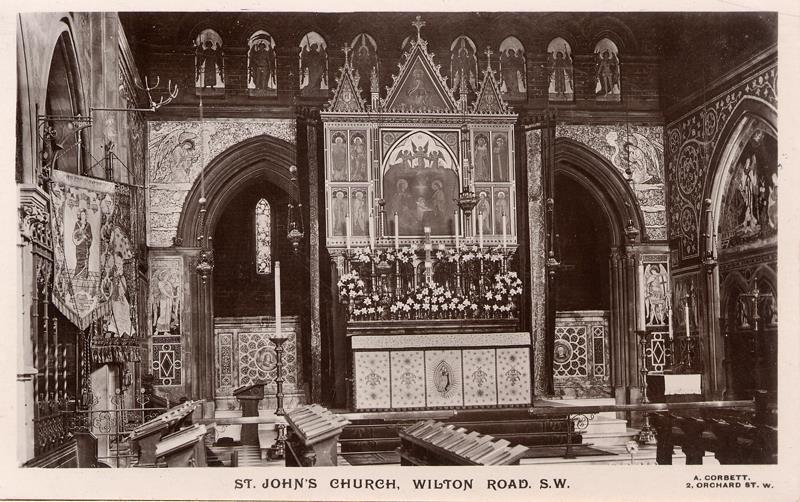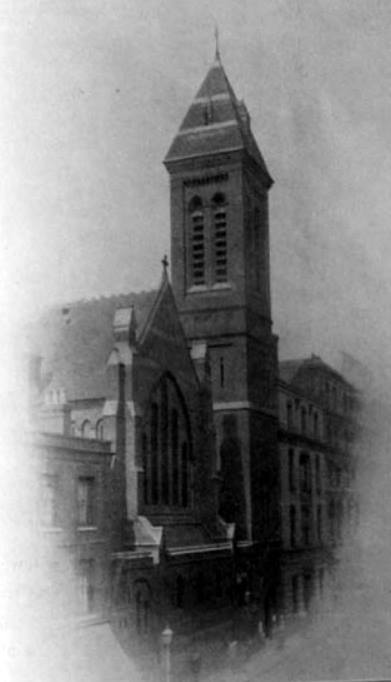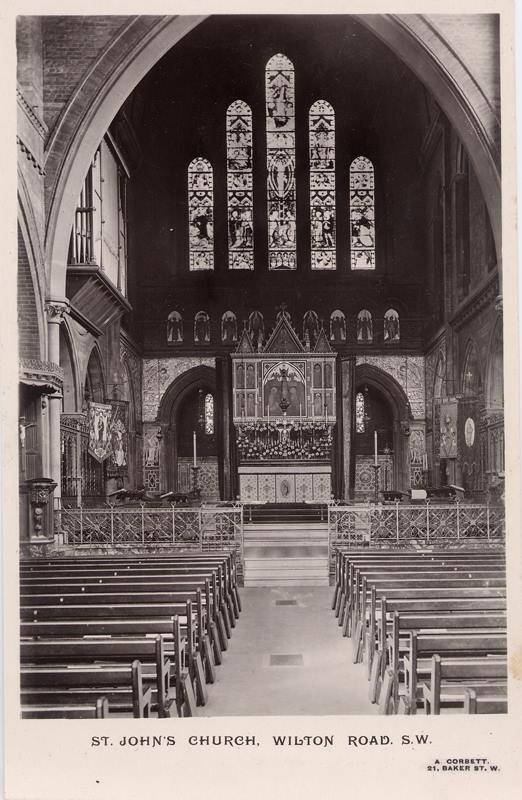St Peter's Eaton Square was first consecrated in 1827 and has had an eventful history since then. The full story of St Peter's has been published as a booklet and is available from the church.
The paragraphs below are a snippet relating to the 'lost church' of St John, Wilton Road.
St John, Wilton Road, SW1
The Church of St John, Wilton Road, was consecrated in 1874 as a 'chapel of ease' to St Peter's Eaton Square in order to reach out to the poor in the heavily populated area around Victoria Station. The Vicar, Revd Wilkinson, wished the church to be open to all. It was built with some difficulty on soft ground where barges used to unload their goods from the Grosvenor Basin, which necessitated a foundation built on piles. Fundraising for its building led to a donation of £2000 from the Duke of Westminster while attending St Peter's one morning, and of £150 from Queen Victoria, on the grounds that she was a parishioner.
The early gothic design by Arthur Bloomfield was built in brick with stone dressings, with a broad nave, a short chancel, and a thin square tower topped by a squat slate spire. Embellishments were added in succeeding years, including mosaics, a marble high altar and triptych, and seven sanctuary lamps in the anglo-catholic style and textiles designed by G.F. Bodley.
The early gothic design by Arthur Bloomfield was built in brick with stone dressings, with a broad nave, a short chancel, and a thin square tower topped by a squat slate spire. Embellishments were added in succeeding years, including mosaics, a marble high altar and triptych, and seven sanctuary lamps in the anglo-catholic style and textiles designed by G.F. Bodley.
In 1878 a ring of 8 bells was supplied by John Warner and Sons, at a cost of £1,100. They were "opened" at the dedication service on 2nd October by members of the Ancient Society of College Youths. Subsequently they had to be removed as they proved too heavy.
St John's became a popular and thriving church in the latter years of the 19th Century and into the 20th, with a strong preaching and teaching tradition and congregation drawn from across London. The Eucharist was the main Sunday service, and Eucharistic vestments were adopted in 1908 (they had been in use at St Peter's for over a decade). It was known for its work, quiet reverence and absence of fussiness.
Through the difficult years of the Great War many members of the church were lost, there was a shortage of clergy and little money. Life returned to normal after the war - incense was introduced in 1924, and the sacrament was reserved. A large bronze crucifix was set up facing Wilton Street as a War Memorial, which is now at St Peter's on the south wall, near the side entrance to the church office and the Knightsbridge Kindergarten.
St John's became a popular and thriving church in the latter years of the 19th Century and into the 20th, with a strong preaching and teaching tradition and congregation drawn from across London. The Eucharist was the main Sunday service, and Eucharistic vestments were adopted in 1908 (they had been in use at St Peter's for over a decade). It was known for its work, quiet reverence and absence of fussiness.
Through the difficult years of the Great War many members of the church were lost, there was a shortage of clergy and little money. Life returned to normal after the war - incense was introduced in 1924, and the sacrament was reserved. A large bronze crucifix was set up facing Wilton Street as a War Memorial, which is now at St Peter's on the south wall, near the side entrance to the church office and the Knightsbridge Kindergarten.
When war broke out in 1939 the church was first closed, as it was too far from an air raid shelter, then reopened for weekday masses, with Sunday services taking place at St Peter's.
On Friday 11th October, 1940, the Church received a direct hit and was mostly destroyed. The remains were pulled down a few years later. The valuable vestments were restored and other items from the interior which survived were given to St Peter's and other churches.
The church had stood on the west side of Wilton Road between Hudson's Place and Gillingham Street. The building now on the site now is number 129 Wilton Road, Pimlico.
With thanks to John Salmon and 'Lost Churches of London' (Facebook), and to the historical booklet, 'St Peter's Eaton Square (1827-1998)' by David Hilary and Michael Melrose, revised and edited by Valerie Smith.
On Friday 11th October, 1940, the Church received a direct hit and was mostly destroyed. The remains were pulled down a few years later. The valuable vestments were restored and other items from the interior which survived were given to St Peter's and other churches.
The church had stood on the west side of Wilton Road between Hudson's Place and Gillingham Street. The building now on the site now is number 129 Wilton Road, Pimlico.
With thanks to John Salmon and 'Lost Churches of London' (Facebook), and to the historical booklet, 'St Peter's Eaton Square (1827-1998)' by David Hilary and Michael Melrose, revised and edited by Valerie Smith.


